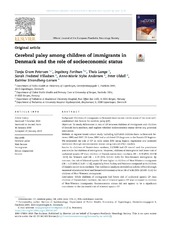| dc.contributor.author | Petersen, Tanja Gram | en_US |
| dc.contributor.author | Forthun, Ingeborg | en_US |
| dc.contributor.author | Lange, Theis | en_US |
| dc.contributor.author | Villadsen, Sarah Fredsted | en_US |
| dc.contributor.author | Nybo Andersen, Anne-Marie | en_US |
| dc.contributor.author | Uldall, Peter | en_US |
| dc.contributor.author | Strandberg-Larsen, Katrine | en_US |
| dc.date.accessioned | 2020-06-03T13:46:12Z | |
| dc.date.available | 2020-06-03T13:46:12Z | |
| dc.date.issued | 2019-05 | |
| dc.Published | Petersen TG, Forthun I, Lange T, Villadsen, Nybo Andersen A, Uldall P, Strandberg-Larsen K. Cerebral palsy among children of immigrants in Denmark and the role of socioeconomic status. European journal of paediatric neurology. 2019;23(3):507-516 | eng |
| dc.identifier.issn | 1090-3798 | |
| dc.identifier.issn | 1532-2130 | |
| dc.identifier.uri | https://hdl.handle.net/1956/22449 | |
| dc.description.abstract | Background Children of immigrants in Denmark have excess risk for some of the most well-established risk factors for cerebral palsy (CP). Objectives To study differences in risk of CP between children of immigrants and children of Danish-born mothers, and explore whether socioeconomic status drives any potential association. Methods A register-based cohort study including 1,274,616 children born in Denmark between 1981 and 2007. Of these, 2807 had a validated CP diagnosis in the Danish CP Register. We estimated the risk of CP as odds ratios (OR) using logistic regression and assessed mediation through socioeconomic status using natural effect models. Results In children of Danish-born mothers, 2.2/1000 had CP overall and the prevalence was similar for children of immigrants. However, children of immigrants had lower risk of unilateral spastic CP than children of Danish native-born mothers; OR = 0.59 (95% CI:0.38–0.91) for Western and OR = 0.79 (95% CI:0.61–1.03) for Non-Western immigrants. By contrast, the risk of bilateral spastic CP was higher in children of Non-Western immigrants (OR = 1.27 (95% CI:1.05–1.53)), especially from Turkey and Pakistan compared with children of Danish native-born mothers. The mediation analysis revealed an indirect effect (through maternal educational level and household income) with an OR of 1.06 (95% CI:0.99–1.14) for children of Non-Western immigrants. Conclusions While children of immigrants had lower risk of unilateral spastic CP than children of Danish-born mothers, the risk of bilateral spastic CP was increased in children of Non-Western immigrants. Socioeconomic status did not appear to be a significant contributor to the increased risk of bilateral spastic CP. | en_US |
| dc.language.iso | eng | eng |
| dc.publisher | Elsevier | eng |
| dc.rights | Attribution CC BY-NC-ND | eng |
| dc.rights.uri | https://creativecommons.org/licenses/by-nc-nd/4.0/ | eng |
| dc.subject | Cerebral palsy | eng |
| dc.subject | Risk factors | eng |
| dc.subject | Immigrants | eng |
| dc.subject | Ethnic disparities | eng |
| dc.subject | Cohort | eng |
| dc.title | Cerebral palsy among children of immigrants in Denmark and the role of socioeconomic status | en_US |
| dc.type | Peer reviewed | |
| dc.type | Journal article | |
| dc.date.updated | 2020-02-03T09:33:45Z | |
| dc.description.version | publishedVersion | en_US |
| dc.rights.holder | Copyright 2019 The Authors | |
| dc.identifier.doi | https://doi.org/10.1016/j.ejpn.2019.01.007 | |
| dc.identifier.cristin | 1714317 | |
| dc.source.journal | European journal of paediatric neurology | |

